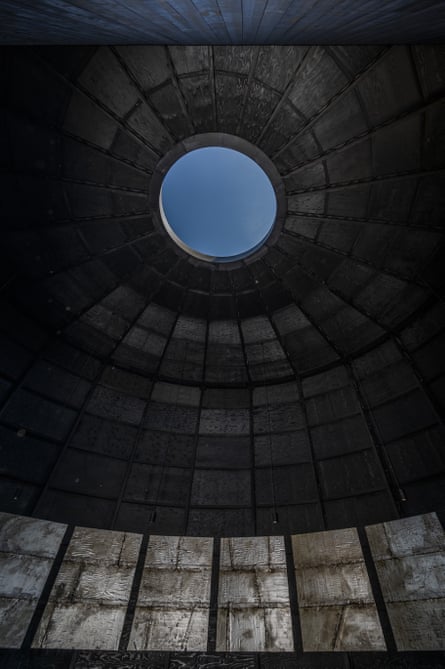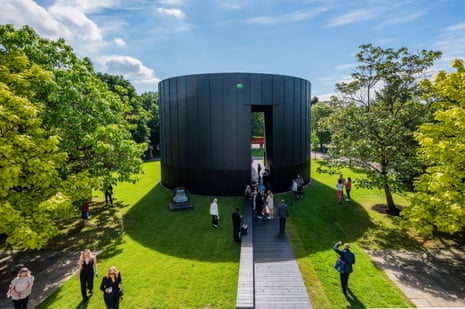Last autumn, at the Whitechapel Gallery in east London, the Chicagoan artist Theaster Gates exhibited works in clay: large, heavy, wrought objects, shaped by hand, formed with intense heat and effort. In last week’s intermittent summer sunshine, outside the Serpentine Gallery in west London, he opened Black Chapel, a timber cylinder clad in dark roofing membrane, its interior divided by an off-centre wall into a larger and a smaller part. It is this year’s edition of the Serpentine’s annual pavilion, a temporary structure usually designed (but not this year) by architects.
It is light where the clay works are heavy. Its charred tone might prompt a thought about energy: how many pavilions would have to burn to fire one of the ceramic pieces? Its early inspirations include the historical, bottle-shaped kilns of Stoke-on-Trent’s potteries, but the design has gone through some evolutions towards something more spare. It now more nearly resembles other kinds of working structure, the silos and granaries of midwestern agriculture.
The desire is to honour labour and making. In particular, Gates wants to pay tribute to his late father, a man who ran a roofing company. “When he was up on a roof,” says the artist, “was the time when he had the most energy … He was happiest when he was working,” and he transmitted his ethos to his son. “I couldn’t imagine that the pavilion would also be a memorial,” says Gates, but he has responded to his father’s recent death by installing seven “tar paintings”, silvery squares made of roofing materials that shine inside the shadowy interior with reflected light.

Alongside its homage to making, Black Chapel aims to evoke, as the name suggests, somewhere religious or spiritual. Gates cites among his inspirations, as well as the kilns and silos, a kind of round church to be found in Hungary. A bell salvaged from a destroyed church in the South Side of Chicago, a weighty and resonant footnote to the more fragile pavilion, stands on the ground outside. In the centre of the pavilion’s ceiling, as in the dome of the Pantheon in Rome, is an unglazed oculus. Two tall doorless openings are formed on opposite sides. When the sun shines, it casts circles and triangles of light and shadow. Such geometries are about what Gates calls “furthering something elemental”.
The structure is not dedicated to any kind of organised faith. Rather, it is meant to be an “opportunity for friendship” as well as for more private “solemnity, quietude and inwardness”. A programme of events – vocal and instrumental music, dance, poetry, pottery workshops – will, it is hoped, make the space reverberate. What unifies Black Chapel with ceramics, says Gates, is that both are vessels. They “help us gather”, whether in the form of small cups at a social event or of a building large enough to hold many people.
As a place of gathering, Gates wants it to be somewhere for “people to feel they are more important than the architecture”. As a piece of plain construction, it aims to go back to first principles: “Before we had architecture, there were people who knew how to build things, to draw things.” In both cases it circumvents the architectural trickery that characterised many past pavilions. “I don’t have any algorithms,” says Gates. Simplicity also means economy, which means he can get more building for the budget – the 10-metre-high pavilion is notably more voluminous than its predecessors.

It’s sometimes a weakness of Serpentine pavilions that mundanities of construction bring flights of fancy down to earth – if the joy of a temporary structure lies in its spontaneity and ephemerality, this can get lost among engineering and building regulations compliance. The construction of Black Chapel, where “all the bones are evident”, makes for a more direct route from conception to realisation. It is perhaps a strength that Gates, as an artist rather than an architect, has a less complicated attitude to building.
His pavilion, though, is still made in a different way from a pot. It is achieved in collaboration with the architect David Adjaye and his practice, with the technical advisers AECOM, and with other consultants and contractors. Ceramics, for sure, also involve partnership with the people expert in the technical processes involved, but it is more hands on, with fewer layers between the artist and the finished object.
There is, as a result, less density of thought and intent in the fabric of this building than there is in Gates’s works in clay. This reduction is no bad thing – otherwise it might be overpoweringly baroque, and would function less well as a backdrop to the human life it contains – but it also runs the risk that there might not be all that much there. There’s a fine line between the simple and the dull.
This is a structure of many allusions and many ambitions invested in one shape. I’d say it pulls it off. Its success is to do with the fact that the decisions about its design are founded in clear ideas about the way people might occupy it. It is helped by the interaction between its almost dumb exterior and the liveliness in and around it – the way light travels around the interior, the way the big slots in the wall frame lush greenery and the pretty, Wren-style architecture of the Serpentine Gallery. Its scale gives it dignity.
In the end, this pavilion is meant to be about people – those who will gather and perform in it as well as those who made it. It seeks to speak to them over the noise of architectural elaboration. Its real test will come with occupation and use.
Black Chapel is at the Serpentine Gallery, London, until 16 October

Comments (…)
Sign in or create your Guardian account to join the discussion